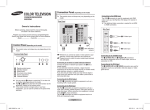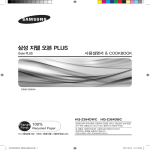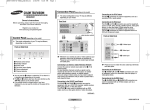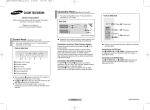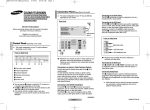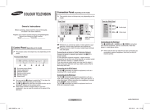Download Samsung CW-29Z508T User Manual
Transcript
COLOR TELEVISION Connection Panel (depending on the model) ➢ The product colour and shape may vary depending on the model. Rear Panel Owner’s Instructions Before operating, please read this manual thoroughly, and retain it for future reference. Side Panel Register your product at www.samsung.com/global/register. Record your Model and Serial number here for future reference. ▪ Model __________ ▪ Serial No. __________ or Control Panel (depending on the model) cable television network ➢ The product colour and shape may vary depending on the model. Front (or Side) Panel 1 2 1 2 3 4 5 6 3 ☛ Whenever you connect an audio or video system to your television, ensure that all elements are switched off. ☛ Please be sure to match the colour coded input terminals and cable jacks. 4 5 6 Remote control sensor Standby indicator Power on/off On-screen menu display Volume adjustment Channel selection You can use the 6 buttons to switch the TV on when it is in standby mode depending on the model. The 5 and 6 buttons also have the same function as the ◄/►/▲/▼ buttons on the remote control. If the remote control no longer works or you have misplaced it, you can use the controls on the panel of the television. Connecting to an Aerial or Cable Television Network Connect the aerial or network input cable to the 1 (75 Ω coaxial socket). To view television channels correctly, a signal must be received by the set from one of the sources: an outdoor aerial, cable television network, or satellite network. If you are using an indoor aerial, you may need to adjust it when tuning your television until you obtain a picture that is both sharp and clear. 1 1 S-Video input 2 Video input 3 Audio input Connecting to the S-VIDEO Input The 1 (S-VIDEO IN) and 3 (AUDIO-L/R) connectors are used for equipment with an S-Video output, such as a camcorder or VCR. Connecting to the RCA Input The 3 (AUDIO-L/R) and 2 (VIDEO) connectors are used for equipment, such as a camcorder, video disc player, or video game device. Connecting to the SCART Input/Output The SCART2 and SCART3 connectors are used for equipment, such as a VCR, DVD, decoder, satellite receiver, video game device, or video disc player. The SCART2 is also used for equipment with an RGB output, such as a video game device or video disc player. Connecting to the Component Input The RCA4 connectors are used for equipment such as a DVD with component output. English - 1 AA68-03904A_Eng.indd Connecting to the HDMI Input The HDMI5 connector is used for equipment with HDMI output, such as a Set-Top Box, DVD player, AV receiver or digital TV. ➢ No additional Audio connection is needed for an HDMI to HDMI connection. AA68-03904A-01 2007-03-30 ソタタ・1:46:01 Remote Control (depending on the model) ➢ Operation of remote control may be affected by bright artificial light near to the TV. ➢ This is a special remote control for the visually impaired, and has Braille points on the POWER, Channel and Volume buttons. 1 POWER Used to switch the TV on and off. 2 Numeric buttons Used to select channels directly. 3 -/-Used to select a channel numbered ten or over. Press this button, then “--” symbol is displayed. Enter the two-digit channel number. 4 CH MGR Used to display channel lists on the screen. 5 TV Used to return to the TV mode when it is in external input mode. 6 / Used to increase or decrease the volume. 7 MENU Used to display the on-screen menu or return to the previous menu. 8 ▲/▼/◄/► Used to control the cursor in the menu. 9 INFO Used to view the channel information and setting status you selected. 0 S.MODE Used to select the sound effect. ! P.MODE Used to select the picture effect. @ DUAL I-II Used to select the sound mode. # TURBO Used to select the turbo sound option. $ SOURCE Used to display all of the available video sources. 2 1 % PRE-CH Used to switch repeatedly between the2 last two channels displayed. 1 ^ SLEEP Used to select a preset time interval for automatic turn off. & SRS Used to select the SRS TruSurround XT mode. * P /P Used to display the next or previous stored channel. ( EXIT Used to exit from any display or return to normal viewing. ) MUTE Used to switch the sound off temporarily. To turn the sound back on, press the MUTE, , or button. a ENTER While using the on-screen menus, press the ENTER button to activate (or change) a particular item. b STILL Used to freeze the current picture. c P.SIZE Used to change the screen size. Installing Batteries Remove the cover. Install two AAA size batteries, then replace the cover. When the remote control does not operate normally, check that the “+” and “–” ends of the batteries are inserted correctly or the batteries are drained. Do not mix battery types, i.e. alkaline and manganese. Switching the Television On and Off The mains lead is attached to the rear of the television 1 Plug the mains lead into an appropriate socket. The main voltage is indicated on the rear of the television and the frequency is 50 or 60Hz. 2 Press the “ I ” button (On/Off) on the front of the television. 3 Press the POWER button on the remote control to switch the television on. The programme that you were watching last is re-selected automatically. If you have not yet stored any channels, no clear picture appears. Refer to “Channel - Auto Store” on page 3 or “Channel - Manual Store” on page 4. If the television is initially powered on, several basic customer settings proceed automatically. Refer to “Setup - Plug & Play” on page 3. ➢ ➢ 4 2 2 To switch the television off, press the “ I ” button (On/Off) on the front of the television. 1 1 Placing the Television in Standby Mode The television can be placed in standby mode, in order to reduce power consumption and wear of the cathode ray tube. Standby mode can be useful when you wish to interrupt viewing temporarily (during a meal, for example). 1 Press the POWER button on the remote control while viewing. The television is in standby mode. 2 To switch the television back on, simply press it again. You can also switch on by pressing the TV ( ), P / P , or numeric button. ➢ ☛ Do not leave the television in standby mode for long periods of time (when you are away on holiday, for example). Turn the television off by pressing the “ I ” button (On/Off) on the front (or side) of the television. It is best to unplug the set from the mains and aerial. ➢ English - 2 AA68-03904A_Eng.indd 2 2007-03-30 ソタタ・1:46:08 2 1 Input (depending on the model) Source List / Edit Name Viewing the Menus 1 Press the MENU button. The main menu is displayed on the screen. Its left side has five icons: Input, Picture, Sound, Channel, and Setup. 2 Press the ▲ or ▼ button to select one of the icons. Press the ENTER button to access the icon’s sub-menu. 3 Press the ▲ or ▼ button to move to items in the menu. Press the ENTER button to enter items in the menu. 4 Press the ▲/▼/◄/► button to change the selected items. Press the MENU button to return to the previous menu. 5 Press the EXIT button to exit from the menu. 3 4 5 1 Plug & Play If the television is in standby Start Plug & Play mode, press the POWER OK button on the remote control. The message Start Plug & Enter Return Play. is displayed. Setup TV To start Plug & Play, press the English Plug & Play Deutsch ENTER button. Français Language : English Nederlands Español The Language menu is Time Italiano Blue Screen : On Svenska displayed. Melody : Português On Ελληνικά Ceština The Language menu will Srpski automatically appear after Move Enter Skip several seconds, even if the ENTER button is not pressed. Press the ▲ or ▼ button to select your country. Press the ENTER button. Country : Search Move Belgium Belgium France Germany Italy Netherlands Spain Sweden Switzerland United Kingdom Others Eastern Europe Enter Skip Search P 1 C-- ----- 87 MHz 10% Press the ◄ or ► button to move to the hour or minute. Set the hour or minute by pressing the ▲ or ▼ button. 7 When you have finished, press the MENU button. Plug & Play The Enjoy your viewing Enjoy your viewing is displayed, and then the channel which has been OK stored will be activated. Move Adjust Skip Plug & Play Language : English Time Blue Screen : On Melody : On Enter TV Ext.1 Ext.2 AV/S-Video Component HDMI Move : : : : : -------------------------- Enter Return Edit Name TV Ext.1 Ext.2 AV S-Video Component HDMI Move : : : : : ---- : ---VCR DVD -----Cable STB HD STB -----Sat. STB AV Receiver ---------------- Enter Return Channel - Auto Store Setup TV Move Select the appropriated language by pressing the ▲ or Plug & Play ▼ button. Press the ENTER Check antenna input. button. OK The Check antenna input. is Enter Skip displayed. If any language is not selected, the language menu will disappear about 30 seconds later. ➢ Source List TV You can change the required external source simply by pressing the SOURCE button on the remote control. It might take a short period of time for pictures to be switched. To return to the TV mode, press the TV button on the remote control. Edit Name You can give a name to the external source. Re-setting the Plug & Play Method: MENU ▲/▼ (Setup) ENTER ▲/▼ (Plug & Play) ENTER Source List You can switch between viewing signal from connected equipment, such as a VCR, DVD, set-top box, and the TV source (broadcast or cable). Stop To search the channels, press the ENTER button. Enter Skip To stop the search, press the Clock Set TV ENTER button. When the channel searching Hour Minute has finished, the Clock Set --menu is displayed. ➢ 2 Auto Store TV 6 Setup - Plug & Play When the television is initially powered on, several basic customer settings proceed automatically and subsequently. The following settings are available. Make sure that the antenna is connected to the television (refer to page 1). Press the ENTER button. The Country menu is displayed. ► ► ► ► ► Return You can scan for the frequency ranges available to you (and availability depends on your country). Automatically allocated programme numbers may not correspond to actual or desired programme numbers. However you can sort numbers manually and clear any channels you do not wish to watch. TV Auto Store Channels are sorted and stored in the order which reflects their ► Country : Belgium Search ► position in the frequency range (with lowest first and highest last). The programme originally selected is then displayed. Move Enter Return To stop the search before it Search has finished, press the ENTER P 1 C-- ----87 MHz 10% button. When finished, the Sort menu Stop Enter Return is displayed. To sort the stored channels into the desired numerical order, refer to “Channel - Sort” on page 4. To exit without sorting, press the EXIT button. ➢ ➢ continued... English - 3 AA68-03904A_Eng.indd 3 2007-03-30 ソタタ・1:46:17 Channel - Manual Store Channel - Channel Manager Channel - Fine Tune You can store channels, including T V Manual Store those received via cable networks. Prog. :P 1 When storing channels manually, ► Colour System :Auto Sound System :B/G ► you can choose: Channel :C-– Whether or not to store each of Search : 40 MHz Store :? the channels found – The programme number of each Move Adjust Return stored channel which you wish to identify Prog.(Programme number to be assigned to a channel) Colour System: Auto / PAL / SECAM / NTSC4.43 Sound System: B/G / D/K / I / L Channel (When you know the number of the channel to be stored) You can also select the channel number directly by pressing the numeric buttons (0~9). Search (When you do not know the channel numbers) The tuner scans the frequency range until the first channel or the channel that you selected is received on the screen. Store (When you store the channel and associated programme number) Channel Manager You can exclude the channels you have P 1 C 4 1/15 chosen from the channels you scanned. Prog. 1 C 4 ▲ When you scan through the stored 2 C-3 S 1 channels, those you have chosen to skip 4 S 3 5 S 6 are not displayed. 6 S 8 7 S10 ▼ Add All of the channels that you do not Move Enter Page Return specifically choose to skip are displayed during scanning. It can be displayed simply by pressing the CH MGR (Channel Manager) button. Fine Tune If the reception is clear, you do not P 2 * have to fine-tune the channel, as Reset this is done automatically during Move the search and store operation. Adjust Return If however the signal is weak or distorted, you may have to fine-tune the channel manually. ➢ ➢ If there is no sound or abnormal sound, re-select the sound standard required. ☛ Channel mode P (Programme mode): When completing tuning, the broadcasting stations in your area have been assigned to position numbers from P00 to P99. You can select a channel by entering the position number in this mode. C (Air channel mode): You can select a channel by entering the assigned number for each air broadcasting station in this mode. S (Cable channel mode): You can select a channel by entering the assigned number for each cable channel in this mode. ➢ Method: ▲/▼ : Used to select a channel to be added or erased. ENTER : Used to confirm the channel selected for adding or erasing. +2 Method: ◄/►: You can obtain a sharp and clear picture and good sound quality. ▲/▼ ENTER : You can reset the setting. MENU : You can memorise adjusted picture or sound. Channel - LNA (depending on the model) Channel - Sort This operation allows you to change the programme numbers of stored channels. This operation may be necessary after using auto store. Sort TV From To Store Move : P 1 ---: P-- ---: ? Adjust Return From : Channel number to be changed. To : New channel number to be identified. Store : Confirmation the exchange of channel numbers. Channel TV ▲ More Fine Tune LNA Move : OffOff On Enter Return LNA (Low Noise Amplifier) setting is to be made for each channel. If the picture is noisy with the LNA set to On, select Off. Depending on areas, factory mode of LNA will be set up as On or Off. Setup - Time Channel - Name Channel names will be assigned automatically when channel information is broadcast. These names can be changed, allowing you to assign new names. This function is very useful in the situation that the TV is used in weak signal. LNA amplifies the TV signal in the weak signal area, but not noise. Name TV Prog. 13 14 15 16 17 Move Сh. C21 C23 C25 C26 C28 ▼ Adjust Method: ▲/▼ : Used to select a letter or number. ◄/► : Used to move to the previous or next letter. ENTER : Used to confirm the new name. Name А ----------------Return Time TV Clock Set ► Clock Set : -- : -You can set the television Sleep Timer : Off ► clock so that the current time On Timer : Off ► is displayed when pressing Off Timer : Off ► the INFO button on the remote control. You must also Move Enter Return set the time if you wish to use the automatic on or off timers. When pressing the “ I ” button (On/Off) on the front of the television, the clock setting will be reset. ➢ continued... English - 4 AA68-03904A_Eng.indd 4 2007-03-30 ソタタ・1:46:18 Picture - Mode Sleep Timer You can select a time period of between 30 and 180 minutes after which the television automatically switches to standby mode. You can select these options simply by pressing the SLEEP button on the remote control. If the sleep timer is not yet set, Off is displayed. If it is already set, the remaining time before which the television switches to standby mode is displayed. ➢ On Timer / Off Timer You can set the On/Off timers so that the television will switch on or off automatically at the time you select. You must set the clock first. ☛ ☛ Auto Power Off When you set the timer “On”, the TV will eventually turn off, if no controls are operated for 3 hours after the TV was turned on by timer. This function is only available in timer “On” mode and prevents overheating, which may occur if a TV is on for too long. Mode Mode : Dynamic / Standard / T V Movie / Custom Mode : Dynamic ► Contrast : 90 ► You can select the type Brightness : 50 ► of picture which best Sharpness : 50 ► Colour : 50 ► corresponds to your viewing requirements. ▼ More You can select these Move Enter Return options simply by pressing the P.MODE button on the remote control. Contrast / Brightness / Sharpness / Colour / Tint (NTSC only) The television has several settings which allow you to control the picture quality. Colour Tone : Cool2 / Cool1 / Normal / Warm1 / Warm2 Reset You can return to the factory defaults. The reset function is set for each mode (Dynamic, Standard, Movie, or Custom). ➢ Language It is variable depending on the model. When you start using the television for the first time, you must select the language which will be used for displaying menus and indications. Setup TV Plug & Play Language : English Time Blue Screen : On Melody : On Move Enter ► ► ► ► ► Return Blue Screen If no signal is being received or the signal is very weak, a blue screen automatically replaces the noisy picture background. If you wish to continue viewing the poor picture, you must set the Blue Screen to Off. ➢ Picture - PIP (depending on the model) You can display a sub picture within the main picture of TV programme or external A/V devices such as VCR or DVD. In this way you can watch TV program or monitor the video input from any connected devices while watching TV or other video input. Picture TV Picture - Size / Digital NR/ Tilt / Film Mode Setup Language / Blue Screen / Melody Film Mode You can automatically sense and process film signals from some sources and adjust the picture for optimum quality. Not available in the Component or HDMI mode. Mode discrepancies, such as turning off Film Mode while viewing a film source or turning on Film Mode while viewing Non-film sources, may affect the picture quality. Picture TV Size: (depending on the model) ► Mode : Dynamic Size : 16:9 ► Nomal / Zoom1 / Zoom2 Digital NR : On ► Auto Wide / 16:9 / Zoom1 / Tilt : 0 Film Mode : Off ► Zoom2 / 4:3 (Wide model) PIP : Off ► You can select the picture size which best corresponds to Move Enter Return your viewing requirements. It is variable depending on the model. You can change the picture size simply by pressing the P.SIZE button on the remote control. Digital NR If the signal received by the television is weak, you can activate this feature to reduce any static and ghosting that may appear on the screen. Tilt (depending on the model) If you find that the picture received is slightly tilted to one side, you can adjust the tilt setting (-7 to +7). ➢ continued... Melody You can hear melody sound when the television is powered on or off. Mode : Size : Digital NR Tilt Film Mode PIP Move Dynamic 16:9 : On : 0 : Off : Off Enter PIP TV ► ► ► ► ► Return PIP Source Swap Size Position Prog. Move ► ► ► ► ► : On : TV : Large : : P 1 Enter Return PIP: On/Off 1 You can activate or deactivate the PIP function. Source 2 You can select a source of the sub-picture. Depending on the models, the sub-picture can be viewed only when a source different from the main picture's is selected. If a TV programme is viewed on the main picture, the sub-picture is not available for TV programmes. If a TV source is selected, the message Not Available is displayed. ➢ Swap 3 You can interchange the main picture and sub-picture. Size: Large / Small / Double Window 4 You can select a size of the sub-picture. Position: / / / 6 You can select a position of the sub-picture. continued... English - 5 AA68-03904A_Eng.indd 5 2007-03-30 ソタタ・1:46:20 Prog. 5 You can select a channel of the sub-picture only when the Source is set to TV. Easy functions of the remote control You can freeze the sub-picture. Auto Volume Each broadcasting station has its own signal conditions, and so it is not easy to adjust the volume every time the channel is changed. This feature lets you automatically adjust the volume of the desired channel by lowering the sound output when the modulation signal is high or by raising the sound output when the modulation signal is low. Turbo Sound This feature suitably emphasizes both higher and lower bands of sound (and includes other effects). You can enjoy more magnificent and dynamic sound when watching music, movie, or other channels. You can change the options simply by pressing the TURBO button on the remote control. Pseudo Stereo This feature converts a monaural sound signal into two identical left and right channels. Once the Pseudo Stereo is set to On or Off, these settings apply to the sound effects such as Standard, Music, Movie, and Speech. ➢ Sound - Mode / Equalizer / SRS TruSurround XT / Auto Volume / Turbo Sound / Pseudo Stereo Sound TV Mode: Standard / Music / Movie / Speech / Custom ► Mode : Custom Equalizer ► You can select the type of SRS TruSurround XT : Off ► special sound effect to be Auto Volume : Off ► Turbo Sound : Off ► used when watching a given Pseudo Stereo : Off ► broadcast. Move Enter Return You can select these options simply by pressing the S.MODE button on the remote control. Equalizer The television has several settings which allow you to control the sound quality. If you make any changes to these settings, the sound mode is automatically switched to Custom. SRS TruSurround XT TruSurround XT is a patented SRS technology that solves the problem of playing 5.1 multichannel content over two speakers. TruSurround delivers a compelling, virtual surround sound experience through any two-speaker playback system, including internal television speakers. It is fully compatible with all multichannel formats. You can select these options simply by pressing the SRS button. TruSurround XT, SRS and ( ) Symbol are trademarks of SRS Labs, Inc. TruSurround XT technology is incorporated under license from SRS Labs, Inc. ➢ ➢ ➢ ☛ continued... Selecting the Sound Mode (depending on the model) The DUAL I-II button displays/ controls the processing and output of the audio signal. When power is switched on, the mode is automatically preset to either “Dual-I ” or “Stereo”, depending on the current transmission. NICAM Stereo Type of broadcast On-screen indication Regular broadcast (Standard audio) Mono (Normal use) Regular + NICAM Mono Mono NICAM ↔ Mono (Normal) NICAM Stereo Stereo NICAM ↔ Mono (Normal) NICAM Dual-I/II Dual-I Dual-II Mono ↔ ↔ NICAM NICAM (Normal) A2 Stereo Type of broadcast On-screen indication Regular broadcast (Standard audio) Mono (Normal use) Bilingual or Dual-I/II Stereo Dual-I Stereo ↔ Dual-II ↔ Mono (Forced mono) ➢ If the receiving conditions deteriorate, listening will be easier if the mode is set to the Mono. If the stereo signal is weak and an automatic switching occurs, then switch to the Mono. When receiving a mono sound in the AV mode, connect to the “AUDIO-L” input connector on the panel (front or side). If the mono sound comes out only from left speaker, press the DUAL I-II button. Important Warranty Information Regarding Television Format Viewing Standard screen format televisions (4:3, the aspect ratio of the screen width to height) are primarily designed to view standard format full-motion video. The images displayed on them should primarily be in the standard 4:3 ratio format and constantly moving. Displaying stationary graphics and images on screen, such as the dark top and bottom letterbox bars (wide screen pictures), should be limited to no more than 15% of the total television viewing per week. Wide screen format televisions (16:9, the aspect ratio of the screen width to height) are primarily designed to view wide screen format full-motion video. The images displayed on them should primarily be in the wide screen 16:9 ratio format, or expanded to fill the screen if your model offers this feature, and constantly moving. Displaying stationary graphics and images on screen, such as the dark side-bars on nonexpanded standard format television video and programming, should be limited to no more than 15% of the total television viewing per week. Additionally, viewing other stationary images and text such as stock market reports, video game displays, station logos, web sites or computer graphics and patterns, should be limited as described above for all televisions. Displaying any stationary images that exceed the above guidelines can cause uneven aging of picture tubes (CRTs) that leave subtle, but permanent burned-in ghost images in the television picture. To avoid this, vary the programming and images, and primarily display full screen moving images, not stationary patterns or dark bars. On television models that offer picture sizing features, use these controls to view the different formats as a full screen picture. Be careful in the selection and duration of television formats used for viewing. Uneven CRT aging as a result of format selection and use, as well as other burned-in images, is not covered by your Samsung limited warranty. continued... English - 6 AA68-03904A_Eng.indd 6 2007-03-30 ソタタ・1:46:22 2 1 Teletext Feature (depending on the model) Most television stations provide written information services via teletext. The index page of the teletext service gives you information on how to use the service. In addition, you can select various options to suit your requirements by using the remote control buttons. For teletext information to be displayed correctly, channel reception must be stable. Otherwise, information may be missing or some pages may not be displayed. Troubleshooting 1 2 ☛ 3 4 5 6 7 8 9 0 ! @ (index) Used to display the index (contents) page at any time while you are viewing teletext. 2 (reveal) Used to display the hidden text (answers to quiz games, 1 it again. for example). To display normal screen, press (hold) Used to hold the 2 display on a given page if the selected page is linked with several secondary pages which follow on automatically. 1 To resume, press it again. (size) Press to display the double-size letters in the upper half of the screen. For lower half of the screen, press it again. To display normal screen, press it once again. 2 (store) Used to store the teletext pages. 1 2 (mode) Press to select the teletext mode (LIST/FLOF). 2 LIST mode, it1switches into the List If you press it in the save mode. In the2 List save mode, you can save teletext page into list using1the (store) button. (sub-page) 1 Used to display the available sub-page. (page up) Used to display the next teletext page. 2 (page down) Used to display the previous teletext page. 1 2 (cancel) Used to display the broadcast when searching for1 a page. (teletext on/mix) Press to activate teletext mode after selecting the channel providing the teletext service. Press it again to overlap the teletext with the current broadcasting screen. Colored buttons (red/green/yellow/blue) If the FASTEXT system is used by a broadcasting company, the different topics covered on a teletext page are colour-coded and can be selected by pressing the 2 coloured buttons. Press one of them corresponding to the required. The page is displayed with other coloured 1 information that can be selected in the same way. To display the previous or next page, press the corresponding coloured button. Before contacting the Samsung after-sales service, perform the following simple checks. If you cannot solve the problem using the instructions below, note the model and serial number of the television and contact your local dealer. No sound or picture Check that the mains lead has been connected to a wall socket. Check that you have pressed the “ I ” button (On/Off) and the POWER button. Check the picture contrast and brightness settings. Check the volume. Normal picture but no sound Check the volume. Check whether the volume MUTE button on the remote control has been pressed. No picture or black and white picture Adjust the colour settings. Check that the broadcast system selected is correct. Sound and picture interference Try to identify the electrical appliance that is affecting the television, then move it further away. Plug the television into a different mains socket. Blurred or snowy picture, distorted sound Check the direction, location and connections of your aerial. This interference often occurs due to the use of an indoor aerial. Remote control malfunctions Replace the remote control batteries. Clean the upper edge of the remote control (transmission window). Check that the “+” and “-” ends of the batteries are inserted correctly. Check that the batteries are drained. Continued... English - 7 AA68-03904A_Eng.indd 7 2007-03-30 ソタタ・1:46:24 OSD Map Input ✽ : It is variable depending on the model. – Source List ✽ – Edit Name ✽ Picture – Mode – Size ✽ Sound Channel – – – – Digital NR Tilt ✽ Film Mode PIP ✽ – – – – – – Mode Equalizer SRS TruSurround XT Auto Volume Turbo Sound Pseudo Stereo – Auto Store – Manual Store – – – – – Setup Channel Manager Sort Name Fine Tune LNA ✽ – Plug & Play – Language ✽ – Time – Blue Screen – Melody – VCR / DVD / Cable STB / HD STB / Sat. STB / AV Receiver / DVD Receiver / Game / Camcorder / DVD Combo / DHR (DVD HDD Recorder) / PC – – – – – – – – – – – Mode – Dynamic / Standard / Movie / Custom Contrast Brightness Sharpness Colour Tint (NTSC only) Colour Tone – Cool2 / Cool1 / Normal / Warm1 / Warm2 Reset Nomal / Zoom1 / Zoom2 Auto Wide / 16:9 / Zoom1 / Zoom2 / 4:3 (Wide model) Off / On – – – – – – – Off / On PIP Source ✽ Swap Size Position Prog. – Off / On – Standard / Music / Movie / Speech / Custom – – – – Off / On Off / On Off / On Off / On – Country – – – – – – – Search Prog. Colour System Sound System Channel Search Store – – – – – – Clock Set Sleep Timer On Timer Off Timer Off / On Off / On Correct Disposal of This Product (Waste Electrical & Electronic Equipment) (Applicable in the European Union and other European countries with separate collection systems) This marking shown on the product or its literature, indicates that it should not be disposed with other household wastes at the end of its working life. To prevent possible harm to the environment or human health from uncontrolled waste disposal, please separate this from other types of wastes and recycle it responsibly to promote the sustainable reuse of material resources. Household users should contact either the retailer where they purchased this product, or their local government office, for details of where and how they can take this item for environmentally safe recycling. Business users should contact their supplier and check the terms and conditions of the purchase contract. This product should not be mixed with other commercial wastes for disposal. – Belgium / France / Germany / Italy / Netherlands / Spain / Sweden / Switzerland / United Kingdom / Others / Eastern Europe – Auto / PAL / SECAM / NTSC4.43 – B/G / D/K / I / L English - 8 AA68-03904A_Eng.indd 8 2007-03-30 ソタタ・1:46:31








